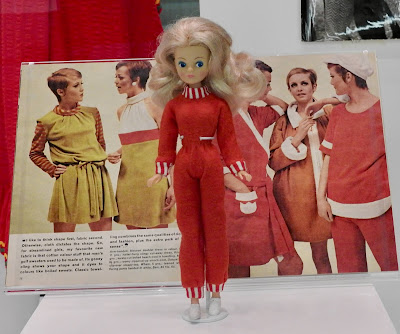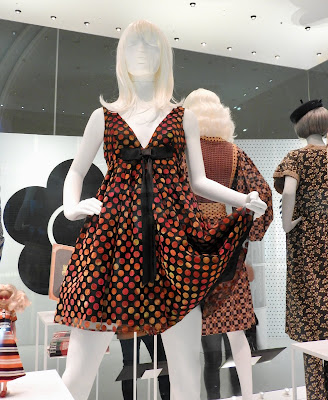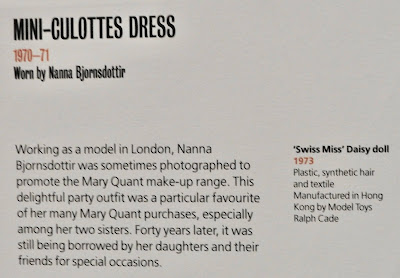目次 / Contents
1) 2階の会場 / First Floor Venue
2) ジャージ・ドレス / Jersey Dress
3) 2世代 / Two Generations
4) おてんば / Tomboyish
5) デイジー人形 / Daisy Doll
1) 2階の会場 / First Floor Venue
Continuing from the previous section, this one is about the Mary Quant Exhibition.
前回に引き続き、マリー・クヮント展 / Mary Quant Exhibitionについてのセクションです。
Continuing from the previous section, this one is about the Mary Quant Exhibition.
 |
マリー・クワイントとマリーのフットウェア(履き物)・コレクションの
発売時のモデル、1967年。
Mary Quant and models at the quantafoot
launch of Mary's footwear collection, 1967.
|
2) ジャージ・ドレス / Jersey Dress
 |
| 締め付けがなくリラックスできる、ジャージ素材の服。 |
 |
緑 : ★
緑のボンデッド・ウール・ジャージー
(ジャージーニットに結合された黒い分厚いウール生地) を使用し、
中央のフロントにジッパーを配した昼用の服。
それは1966年頃にマリー・クアントによって
ジンジャー・グループのために設計されました。
クアントは1963年にジャージ生地の実験を開始しました。
素材の浮き彫りが出る品質は、
彼女のデザインしたいスポーティーなミニドレスによく合いました。
さまざまなデザインと色で生産されたクワントのジャージドレスは、
すぐに彼女の最も人気のある作品の1つになりました。
カラフルなデザインのタイツを考案したのはマリー・クヮントが最初で、
これはクリストバル・バレンシアガ (1895 - 1972)
にインスピレーションを受けたといわれています。
Green : ★
Day dress made from green bonded wool jersey with a zipper down the centre front.
It was designed by Mary Quant for Ginger Group in about 1966.
Quant started experimenting with jersey fabrics in 1963,
the sculptural qualities of the material lending itself well to
the sporty mini-dresses she wanted to design.
Quant’s jersey dresses, produced in a variety of designs and colours,
soon became some of her most popular pieces.
Mary Quant was the first to devise colorfully designed tights, which are said to have been inspired by Cristóbal Balenciaga (1895 - 1972).
|
紙袋 / Paper Bags
3) 2世代 / Two Generations
 |
| 2世代に渡って着用されたレインコート マネキンのポーズにもクワイントの思いが表現されています。 The mannequin pose also expresses Quant's ideas.   |
 |
| 現在でも着て歩けるレインコートですし、バックもOKです。 ああ、もちろん、好みの問題はありますが。 I (or we) can still wear the raincoats and walk around, and the bags are OK. Oh, of course, this is a matter of taste. |
4) おてんば / Tomboyish
 |
| ジェンダーを越えようとしたデザインに思います。 I think the design is trying to transcend gender.  |
左の服 : 下記博物館のサイト:★より
"このドレスはパープルジャージーで作られ、胴体部分の服地とコントラストの袖口、肩章、襟、ネクタイが付いています。
服の長さ、着やすさ、風変わりな襟、ネクタイ、肩章によって、快適さ、色、ユーモアを取り入れることで、当時の慣習に挑戦し、女性のファッションに対するマリー・クワントのアプローチの典型を示しています。
1966年にマリー・クアントによって彼女の英国のジンジャー・グループ・ラベルのためにデザインされました。
マリー・クアントは、1960年代の最も重要な英国のファッション・デザイナーの1人でした。
彼女は夫のアレクサンダー・プランケット・グリーン (1957 - 1990) とビジネスパートナーのアーチー・マクネアとともに、1955年に最初のブティック、バザールをキングスロードにオープンしました。
彼女は元々は卸売業者から洋服を仕入れていましたが、すぐに利用可能なオプションに不満を抱き、独自のデザインを始めました。 製造と販売に成功した服。
1963年、クアントはジンジャー・グループ・レーベルを設立し、バザールよりも低価格で商品を販売しました。"
彼女は夫のアレクサンダー・プランケット・グリーン (1957 - 1990) とビジネスパートナーのアーチー・マクネアとともに、1955年に最初のブティック、バザールをキングスロードにオープンしました。
彼女は元々は卸売業者から洋服を仕入れていましたが、すぐに利用可能なオプションに不満を抱き、独自のデザインを始めました。 製造と販売に成功した服。
1963年、クアントはジンジャー・グループ・レーベルを設立し、バザールよりも低価格で商品を販売しました。"
Clothes on the left : According to the Museum's Website : ★
"This dress is made from purple jersey and has contrasting tan cuffs, epaulettes, collar and tie.
It epitomises Mary Quant’s approach to fashion for women, challenging the conventions of its time, by introducing comfort, colour and humour, as typified by its length, ease of fit, quirky collar, tie and epaulettes.
It was designed by Mary Quant for her Ginger Group label in England in 1966.
It was designed by Mary Quant for her Ginger Group label in England in 1966.
Mary Quant was one of the most important British fashion designer of the 1960s.
Along with her husband, Alexander Plunket Greene (1957 - 1990) and business partner Archie McNair, she opened her first boutique, Bazaar, on the King’s Road in 1955.
She originally stocked clothes from wholesalers but soon became frustrated with the options available and began making her own designs for clothes that were manufactured and sold successfully.
In 1963 Quant set up the Ginger Group label, through which she sold pieces at a lower price point that at Bazaar."
Along with her husband, Alexander Plunket Greene (1957 - 1990) and business partner Archie McNair, she opened her first boutique, Bazaar, on the King’s Road in 1955.
She originally stocked clothes from wholesalers but soon became frustrated with the options available and began making her own designs for clothes that were manufactured and sold successfully.
In 1963 Quant set up the Ginger Group label, through which she sold pieces at a lower price point that at Bazaar."
右の服 : ★
"1967年頃にマリー・クワントがジンジャー・グループのためにデザインしたアンサンブル。
ブラウスやロールネックのジャンパーと合わせて、彼女の定番の作業着になりました。
ウールスーツ素材とチョッキは、どちらも伝統的にメンズ・ウェアに関連していたもので、クワントがファッションを通して、ジェンダーの決まり事を遊び心で崩して見せています。
このデザインのバリエーションは、スカートよりも半ズボンを着用するバージョンがファッション写真に見られます。
同じデザインがツィード生地で、1967年3月のヴォーグで取り上げられ、モデルのツイッギー/ Twiggy (1949 ~) が着用しました。"
ブラウスやロールネックのジャンパーと合わせて、彼女の定番の作業着になりました。
ウールスーツ素材とチョッキは、どちらも伝統的にメンズ・ウェアに関連していたもので、クワントがファッションを通して、ジェンダーの決まり事を遊び心で崩して見せています。
このデザインのバリエーションは、スカートよりも半ズボンを着用するバージョンがファッション写真に見られます。
同じデザインがツィード生地で、1967年3月のヴォーグで取り上げられ、モデルのツイッギー/ Twiggy (1949 ~) が着用しました。"
Clothes on the right : According to the Museum's Website : ★
"Ensemble designed by Mary Quant for Ginger Group in about 1967.
It became one of her staple work outfits, worn with a blouse or roll-necked jumper.
The use of wool suiting material, as well as a waistcoat, both traditionally associated with menswear, demonstrate Quant’s playful subversion of gender stereotypes through fashion.
Variations of this design can be found in fashion photography, including a version in which shorts rather than a skirt are worn.
The same design, in tweed, featured in Vogue, March 1967, worn by the model Twiggy (1949 ~) ."
It became one of her staple work outfits, worn with a blouse or roll-necked jumper.
The use of wool suiting material, as well as a waistcoat, both traditionally associated with menswear, demonstrate Quant’s playful subversion of gender stereotypes through fashion.
Variations of this design can be found in fashion photography, including a version in which shorts rather than a skirt are worn.
The same design, in tweed, featured in Vogue, March 1967, worn by the model Twiggy (1949 ~) ."
5) デイジー人形 / Daisy Doll
マリー・クワイントの服を着たマネキンのそばに、リカちゃん人形のような人形が展示されているコーナー (ガラスケース) がありました。
何故?と疑問に思いました。
その人形は、デイジー / Daisy 人形と呼ばれ、マリー・クワイントがデザインしたものでした。
デイジー人形は、洋服も、身につけている小物もよくできています。
それらはみな、マリー・クワイントがデザインしました。
Daisy Doll
Next to the mannequin dressed in Mary Quant, there was a corner (glass case) where dolls like Licca-chan dolls in Japan were exhibited.
Why? I was wondering.
The doll is called the 'Daisy' doll and was designed by Mary Quant.
Daisy dolls had well made clothes and small items that they wear.
They were all designed by Mary Quant.
 |
 |
 |
 |
 |
  |
 |
  |
赤いワンピース(左) , 1962
下記、博物館のサイト: ★,より
"V&Aコレクションのマリー・クワントの最も初期の作品の1つであるこのシフトドレス(ワンピース)は、彼女が慣習に反し、特に若いお客向けの服を作った形を示しています。
1960年代のユースクエイク (Youthquake : ★)が始まるまで、娘は母親のように服を着る以外に方法はありませんでした。
マリークワントは時代に合わせて、若々しい魅力を備えたこの鮮やかな赤いワンピースなどのスタイルで、独自のアイデンティティを提供しました。"
Red Shift Dress, on the Left, 1962
According to the Museum's Website: ★
"Now one of the earliest works by Mary Quant in the V& A's collection, this shift illustrates how she broke with convention and made clothes specifically for young customers.
Until the beginning of the 1960s youth quake (Youthquake : ★), daughters had no alternative but to dress like their mothers. In tune with the times, Mary Quant offered them identities of their own with styles such as this vivid red shift with youthful appeal."
 |
 |
 |
  |
 |
| ハックルベリー・デイジー人形。 1973 Huckleberry Daisy Doll. 1973   |
 |
  びっくりのバック! Surprising Back! |
 |
  |
 |
| Daisy Poster, 1973 画像は下記より / This from below ★ |
 |
| これらが馴染みがある商品です。 These are familiar products.  |
ファッション関係の展覧会は、私にとっては、珍しいので刺激になりました。
楽しい展覧会でした。
For me fashion-related exhibitions are rare, so, inspiring to me.
This was an enjoyable exhibition.
 |
| このTシャツを自分用に、部屋着として買いました。 I bought this T-shirt for myself as loungewear. 画像は下記より / This from below ★ |
















0 件のコメント:
コメントを投稿